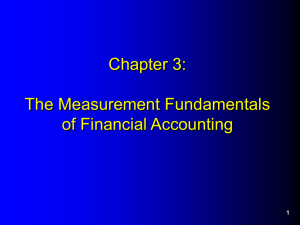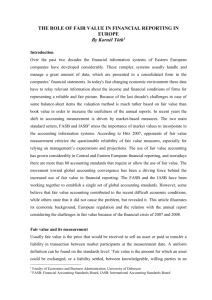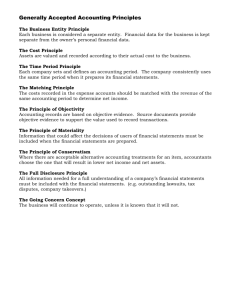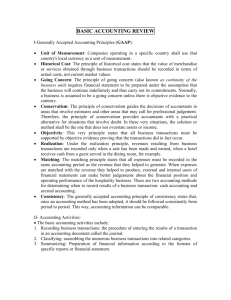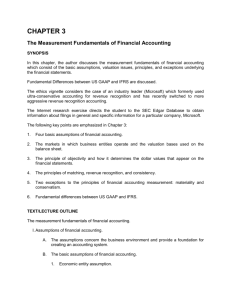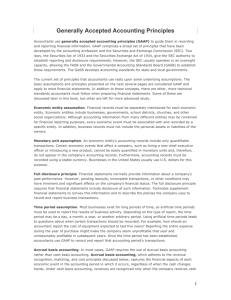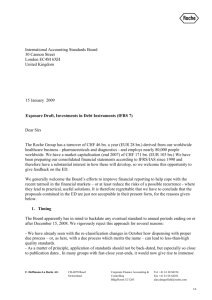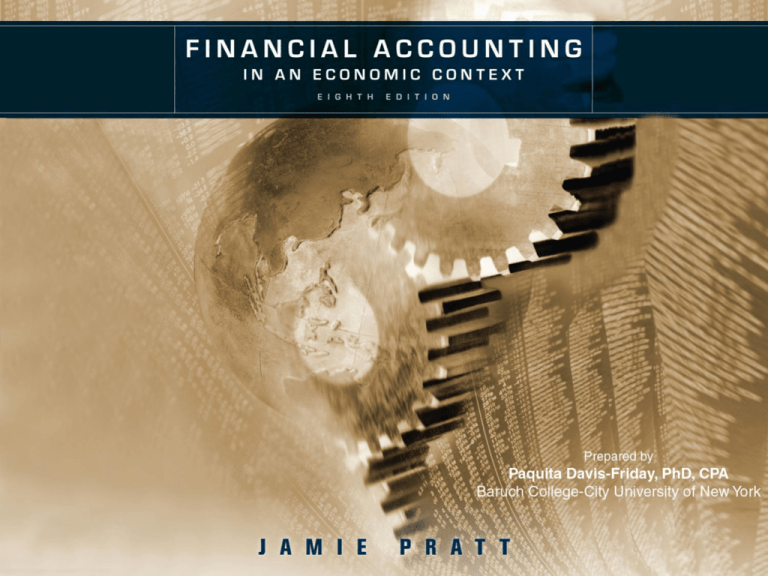
1
Chapter 3:
The Measurement Fundamentals
of Financial Accounting
2
Basic Assumptions
Basic assumptions are foundations of
financial accounting measurements
The basic assumptions are
– Economic entity
– Fiscal period
– Going concern
– Stable dollar
3
Economic Entity
A company is assumed to be a separate
economic entity that can be identified
and measured.
This concept helps determine the scope
of financial statements.
Examples — Disney and ABC, General
Electric and NBC.
4
Fiscal Period (Periodicity)
It is assumed that the life of an
economic entity can be broken down
into accounting periods.
The result is a trade-off between
objectivity and timeliness.
Alternative accounting periods include
the calendar or fiscal year.
5
Going Concern
The life of an economic entity is
assumed to be indefinite.
Assets, defined as having future
economic benefit, require this
assumption.
Allocation of costs to future periods is
supported by the going concern
assumption.
6
Stable Dollar (Monetary Unit)
The value of the monetary unit used to
measure an economic entity’s
performance and position is assumed
stable.
If true, the monetary unit must maintain
constant purchasing power.
Inflation, however, changes the monetary
unit’s purchasing power.
If inflation is material, the stable dollar
assumption is invalid.
7
Valuations on the Balance Sheet
There are a number of ways to value
assets and liabilities on the balance sheet:
– Input market: cost to purchase materials,
labor, overhead
– Output market: value received from sales of
services or inventories
Alternative valuation bases
–
–
–
–
Present value
Fair market value
Replacement cost
Original (historical) cost
8
Present Value as a Valuation Base
Discounted future cash inflows and
outflows
For example, the present value of a
notes receivable is calculated by
determining the amount and timing of its
future cash inflows and adjusting the
dollar amounts for the time value of
money.
9
Fair Market Value as a Valuation Base
Fair market value is measured by the
sales price or the value of goods and
services in the output market.
For example, accounts receivable are
valued at net realizable value which
approximates fair market value.
10
Replacement Cost as a Valuation Base
Replacement cost is the current cost or
the current price paid in the input
market.
For example, inventories are valued at
original cost or replacement cost,
whichever is lower.
11
Historical Cost as a Valuation Base
Historical cost is the input price paid when
asset originally purchased.
For example, land and property used in a
company’s operations are all valued at
original cost.
Under IFRS, certain companies are allowed
to value property, plant, and equipment at fair
market value.
“Cash equivalent price” is used to calculate
historical cost when cash is not paid (as in the
issue of a liability to purchase the asset)
12
Principles of Financial Accounting
Measurement
When transactions occur, we must decide when to
recognize the transactions in the financial
statements, and how to measure the transactions.
The principles of recognition and measurement
are:
– Objectivity
– Revenue recognition
– Matching
– Consistency
13
The Objectivity Principle
This principle requires that the values of
transactions and the assets and
liabilities created by them be verifiable
and backed by documentation.
For example, present value is only used
when future cash flows can be
reasonably determined.
14
The Revenue
Recognition Principle
This principle determines when revenues
can be recognized.
This principle triggers the matching principle,
which is necessary for determining the
measure of performance.
The most common point of revenue
recognition is when goods or services are
transferred or provided to the buyer (at
delivery).
15
Exercise 3-5
Cascades Enterprises ordered 4,000 brackets from
McKey and Company on December 1, 2011, for a
contracted price of $40,000.
Dec 1, 20011: Cascades orders brackets
Jan 17, 2012: McKey completed manufacturing
Feb 9, 2012: McKey delivered the brackets
Mar 14, 2012: McKey received a check for $40,000
•
a. Assume
that McKey prepares monthly
income statements. In which month should
it recognize the $40,000 revenue?
The most common point at which a company
would recognize revenue is at the time of
delivery. So in this case McKey and
Company would recognize revenue in
February.
b. What
are the four revenue recognition
criteria?
The
four criteria for recognizing revenue
are (1) the company has completed a
significant portion of the production and
sales effort, (2) the amount of revenue can
be objectively measured, (3) the company
has incurred the majority of costs, and
remaining costs can be reasonably
estimated, and (4) cash collection is
reasonably assured.
c. Are
there conditions under which the
revenue could be recognized in a month
different from the one chosen in (a)?
Revenue
could be recognized (1) during
production, (2) at the completion of
production, (3) at the point of delivery, or (4)
when the cash is collected. Since the
production and sales effort was not really
complete until McKey shipped the brackets
on February 9, February 9 appears to be the
appropriate date to recognize the revenue.
d. Why
is the timing of revenue
recognition important?
McKey's
managers could be interested in
the timing of revenue recognition due to
incentives provided by contracts. For
example, the managers may be paid a
bonus based upon accounting income.
The Matching Principle
Matching focuses on the timing of recognition of
expenses after revenue recognition has been
determined.
This principle states that the efforts of a given
period (expenses) should be matched against the
benefits (revenues) they generate.
For example, the cost of inventory is initially
capitalized as an asset on the balance sheet; it is
not recorded in Cost of Goods Sold (expense) until
the sale is recognized.
21
22
The Consistency Principle
Generally accepted accounting principles
allow a number of different, acceptable
methods of accounting.
This principle states that companies should
choose a set of methods and use them from
one period to the next.
For example, a change in the method of
accounting for inventory would violate the
consistency principle.
However, certain changes are permitted with
sufficient disclosure regarding the change.
23
Exceptions (Constraints) to the
Basic Principles
These exceptions contradict the basic
principles, in certain circumstances.
They are:
– Materiality
– Conservatism
24
Materiality
Materiality (the immateriality constraint)
– Only transactions with amounts large
enough to make a difference are
considered material.
– Nonmaterial transactions can be given
alternative treatments
For example, a trash can might have a five
year life, but the materiality constraint allows
a company to expense the item in the year
purchased.
25
Conservatism
The conservatism constraint permits the choice of
the more conservative alternative in certain
situations where two alternatives exist regarding
the valuation of a transaction.
Conservatism - When in doubt:
– Understate assets
– Overstate liabilities
– Accelerate recognition of losses
– Delay recognition of gains
For example, “lower of cost or market” is used to
value inventory.
Problem: Some managers have abused the
conservatism constraint in earnings management.
26
International Perspective
Conservatism is pervasive in foreign
financial statements.
In Japan and most of western Europe,
where creditors provide large amounts of
capital, companies prepare reports that
contain intentional understatement of
assets and overstatement of liabilities.
Such practices are more difficult under
IFRS, but many believe that the additional
discretion available to management under
IFRS is still used to reduce reported
earnings.
27
Fundamental Differences – US GAAP
and IFRS
IFRS is “principles-based” while US GAAP
is “rules-based”
IFRS leaves more discretion to
management
US GAAP generally does not allow the
use of fair market values unless they can
be objectively determined.
IFRS allows adjustments to the balance
sheet values for changes in market value.
28
Copyright
Copyright © 2011 John Wiley & Sons, Inc. All rights reserved.
Reproduction or translation of this work beyond that permitted in
Section 117 of the 1976 United States Copyright Act without the
express written permission of the copyright owner is unlawful. Request
for further information should be addressed to the Permissions
Department, John Wiley & Sons, Inc. The purchaser may make backup copies for his/her own use only and not for distribution or resale.
The Publisher assumes no responsibility for errors, omissions, or
damages, caused by the use of these programs or from the use of the
information contained herein.
29

